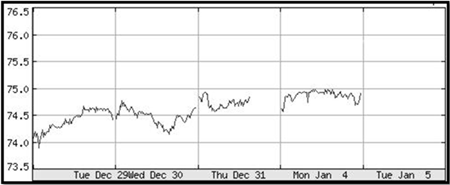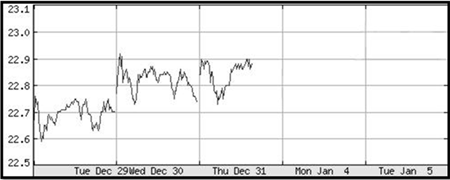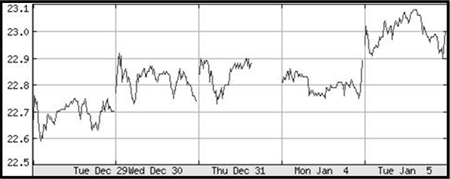To become better acquainted with CFD’s we should walk through a couple of real life trading examples. First we will examine a long CFD where we hope to profit from an upwards move in the market, and we will finish with a short example where we anticipate a drop in the market.
Cash, Margin, and Transaction Fees
Before trading, we quickly calculate how much capital we have to trade with and how much leverage we will be using. Our CFD provider requires 5% margin. Because we have $10,000 to work with, we have an effective $200,000 of asset leverage.
Next we calculate our fees for buying and selling our CFD. We will assume our provider gives us a rate of $15 per entry and exit transaction. This totals $30 roundtrip.
Finally, we need to work out our overnight financing rate. If the current rate is 4% and our broker tacks on an extra 3%, then our daily rate will be 0.0192% or $1.92 daily fees per $10,000 dollars. If we leverage a total of $200,000 we will need to pay $38.40 in overnight financing charges.
Finding the Stock and Trading Long
Our next task is to find a stock to purchase a long CFD on. We have been watching the long term progress of the company RIO as it rose from $50 per share in July of 2009 up past $70 per share in Jan 2010. On January 4th, 2010, we decide to purchase a long CFD contract while watching this very short term 5 day chart.

If the asset was at $75 at the time of purchase, our CFD would cost $3.75 (75/20) per share assuming 5% margin rate. We decide to purchase 2500 CFD’s for the cost of $9375.00. We hold overnight and the price jumps up unexpectedly.
We get so excited that we sell at exactly $76 the next morning. How much money did we make?
- We profited $1 per share x 2500 shares = $2500 total
- We paid out $30 in transaction fees
- Our overnight financing fee was $36 (2500 shares x $75 per share / .0192%* financing)
*CFD overnight interest rate is 7%
Our net is $2500 - $30 - $36 = $2434. This is a pretty awesome return for leveraging less than $10,000 and trading over a two day span.
Finding the Stock and Trading Short
For our next trade we are expecting the market to fall. We therefore decide to short a stock by selling shares in the form of a CFD. We are bearish on the stock ANZ Banking Corp. Group Ltd. On December 31, 2009, as the stock drops intra-day to $22.80 we take up a short position with 8500 CFDs.

Our total cost for this position will be as follows:
- 8500 CFDs x $1.14 (5% margin requirement) = $9690
- Transaction fees: $15 to enter
But the stock unexpectedly does this on January 5th, 2010.

We quickly exit the stock at $23.00. What will be our total loss?
First let’s calculate the interest we will have owing to us. Recall that when in a short position with a CFD the interest is paid to you. The rate is 4% and our provider takes 3% away, leaving us with 1% annual interest. This relates into 0.0027% daily interest paid to us.
- 8500 shares x $22.90 average price = $194,650
- $194,650 x 0.0027% daily interest x 5 days held = $26.28 interest gained.
But how much did we lose?
- $30 in transaction fees
- Loss of 0.10 per share times 8500 shares = $850 loss
Total Loss: $850 + $30 - $26.28 = $853.72
CFD Trading Examples
Of course, each trading example is going to be different. You may have a different financing rate, commission fees, and strategy for exiting. Or your broker may even have an automatic stop-loss in play for you. Do not forget that as the position goes against you there will be a ‘margin call’ whereby you can add capital to maintain the trade or close the position out.
These two scenarios should help visualise the process of going long and short on CFD’s.